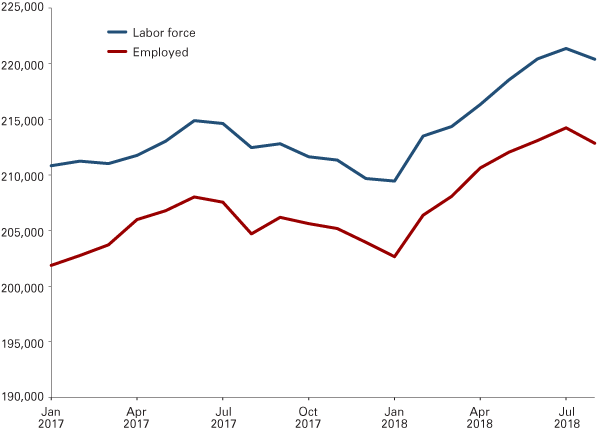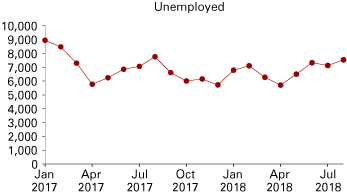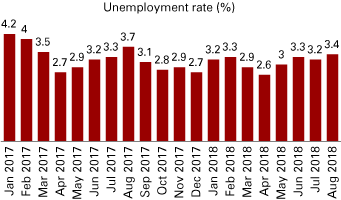Fort Wayne forecast 2019

Director of the Community Research Institute, Indiana University–Purdue University Fort Wayne
When Chicago Federal Reserve Bank President Charles Evans visited Fort Wayne in September, he described the U.S. economy’s fundamentals of growth as “quite solid” with a healthy labor market, growth in gross domestic product and strong consumer spending.1 Many of those trends are seen at the local level in Fort Wayne.
As the U.S. economy heads toward 10 years of economic growth, the Fort Wayne Metropolitan Statistical Area (MSA) of Allen, Wells and Whitley counties continues to enjoy strong economic performance, especially when it comes to the labor market.
Labor market and unemployment
Over about a year and a half, comparing monthly seasonally unadjusted numbers for the Fort Wayne MSA, the labor market has grown by almost 10,000 people; and more interestingly, the number of employed people has grown by nearly 11,000 (see Figure 1),2 reflecting a 5 percent increase. This growth has all occurred while the number and rate of unemployed has shrunk. This tells us that people who were disengaged from the labor market one month are jumping directly into the labor pool next month as employed, rather than spending much time seeking work without landing a job.
Figure 1: Labor force and employment in the Fort Wayne MSA

Source: Local Area Unemployment Statistics (LAUS) from the Indiana Department of Workforce Development
This slack—people who aren’t actively looking but who will join the labor force for the right position—could be limiting upward pressure on wages.3 Average 2018 wage data won’t be available until spring, but anecdotal evidence continues to indicate a tight labor market that could be driving up wages in some sectors.
For the unemployment rate, the Fort Wayne MSA and the rest of the counties that make up what is generally known as northeast Indiana have enjoyed full employment (unemployment below 5.0 percent) since April 2015.4 Furthermore, the Fort Wayne metro has also enjoyed an unemployment rate below the state’s rate for many months in the past four years. Figure 2 shows the number of unemployed, as well as the unemployment rate, since January 2017.
Figure 2: Unemployment in the Fort Wayne MSA


Source: Local Area Unemployment Statistics (LAUS) from the Indiana Department of Workforce Development
Significant downtown projects underway
Investment in downtown Fort Wayne from both the public and private sectors has been strong in recent years, indicating confidence in the Fort Wayne economy’s future, especially as it relates to the urban core. More than $426 million of projects are either recently completed, under construction or under consideration in Fort Wayne’s downtown and adjacent neighborhoods (see Table 1).
Table 1: Downtown project list
| Project name | Description | Status | Total cost |
|---|---|---|---|
| Skyline Tower | 12-story mixed-use tower with first-floor retail, office and apartments | Completed | $42 million |
| Hampton Inn & Suites | 136-room hotel across from Grand Wayne Center | Under construction | $20 million |
| Phase I Riverfront Fort Wayne | Multiuse park and public space | Under construction | $20 million |
| Phase II and III Riverfront | Public and private spaces | In development | TBD |
| Electric Works | Revitalization of 39-acre General Electric campus | Proposed | $220 million to $300 million |
| The HIVE | 6-story mixed use project with retail, offices, apartments and parking garage | In development | $62 million |
| The Landing | Reuse of 7 buildings and new construction of 1 building in a 1-block stretch | Under construction | $35 million |
| Provenance Boutique Hotel | 125-room boutique-style hotel | In development | $27.7 million |
| North River | 29-acre vacant site immediately north of downtown with potential for mixed-use development | Proposed | TBD |
Source: Public data sources and City of Fort Wayne Public Information Office
Skyline Tower, a mixed-use $42 million 12-story high-rise adjacent to the Ash Brokerage headquarters at Skyline Plaza that opened the year before, had the ribbon cutting in September with more than half of the apartments rented.5
Construction is underway for a new $20 million 136-room Hampton Inn & Suites across from the Grand Wayne Center and next to the Courtyard Fort Wayne Downtown. It is scheduled to open in 2019 as downtown’s third hotel.
The first phase of the Riverfront Fort Wayne project—Promenade Park—is slated to open in summer 2019. This $20 million project has a mix of city funds and private investment. Phases II and III of Riverfront have portions of funding ready from a 2017 local income tax increase, and construction could start before 2019 ends.
The proposed Electric Works project on the former 30-plus-acre site of the General Electric plant just south of downtown enjoys substantial support from residents for reuse and revitalization,6 but comes with a significant public funding price tag. The developers’ ask from public coffers totals more than $65 million, with $16.5 million fully committed from city and county government. In November, the Allen County–Fort Wayne Capital Improvement Board approved a $45 million bond funded by the 1 percent supplemental food and beverage tax. Reported total project costs are estimated between $220 million to $300 million. Modeled after other industrial revitalization projects like the American Tobacco Campus in Durham, North Carolina, Electric Works holds the promise of being a transformational project for Fort Wayne and northeast Indiana but still needs additional leasing commitments to fulfill promises with these local-government funders.
Other downtown projects either underway or under consideration include:
The Landing: After many failed starts over the decades, seven existing structures and new construction of another make up The Landing project, located a few blocks from the St. Marys River. The developer is Model Group out of Cincinnati with financial support from city government and the Fort Wayne Downtown Development Trust. Following the successful mixed-use model of first-floor retail and dining with office space and apartments above, this $35 million project is located in a single-block stretch and is scheduled to open in spring 2019.
Boutique hotel: Planned for the corner of Main and Harrison streets, this proposed $27.7 million 125-room hotel from Pacific Northwest-based Provenance Hotels and Vera Bradley founder Barbara Baekgaard will offer an upscale boutique hotel experience. Not yet under construction, this would be Provenance’s first Indiana property and downtown’s fourth hotel.
North River: Minnesota-based Continental Property Group is the sole developer remaining in the process to redevelop the vacant former OmniSource property immediately north of downtown Fort Wayne. This proposal includes Headwaters Junction, an education, entertainment and event space to celebrate the city’s railroad history and house the steam locomotive known as the 765 when it’s not traveling the country, but no formal commitments from the developer or city government have been made to date on this project. Regardless, this 29-acre site offers significant opportunities for future growth in the Riverfront district.
-
The HIVE: Another mixed-use development from a corporate spinoff of Continental Property Group is proposed for the corner of Superior and Calhoun streets and could be an anchor of private-sector investment near the riverfront. The plans for the nearly $62 million six-story project include more than 550,000 square feet with about 220 apartments, first-floor retail space and a parking garage.
Aunt Millie’s Bakeries site: With no plans included in October’s purchase announcement, Fort Wayne-based music and pro audio retailer Sweetwater Sound and Sweetwater founder Chuck Surack intends to buy the Aunt Millie’s Bakeries’ former downtown bakery, which ceased baking bread earlier in 2018. Aunt Millie’s corporate offices will remain there, but the site is well positioned for future development by one of Fort Wayne’s top employers with a national reach.
Wages increasing but still lagging
The Fort Wayne MSA’s average annual wage in 2017 was $44,097, which was a 3.5 percent increase from 2016, according to the U.S. Bureau of Labor Statistics’ Quarterly Census of Employment and Wages. However, that still puts the region with Indiana’s second-largest city behind the average wage for the United States ($55,331) and Indiana ($46,422). No Indiana MSA was above the 2017 national average and only three Indiana counties—Pike, Posey and Marion—exceeded the $55,331 threshold, none of which are in northeast Indiana.
Taking a look outside the Fort Wayne MSA, two northeast Indiana manufacturing-heavy counties have average wages above Indiana’s: DeKalb at $47,269 and Kosciusko at $49,104.
Using a slightly different measure—BLS average hourly earnings for private industry—Fort Wayne’s MSA wages grew 12.2 percent between August 2013 and August 2018 when accounting for inflation, according to an analysis by Garner Economics.7 Using 2018 dollars, Fort Wayne was at $22.89 in 2013 and then $25.68 an hour five years later. Fort Wayne’s increase was the second-highest in the state with only Lafayette-West Lafayette outpacing Fort Wayne at 15.6 percent. The state’s increase was 4.5 percent in this time frame.
2019 outlook
It’s always tempting to see whatever is immediately happening as the long-term outlook. During the Great Recession with unemployment getting close to double digits, it looked like the labor market may never see full employment again. Now that the Fort Wayne MSA has been below 5.0 percent unemployment for more than three years, it is hard to imagine anything but a tight labor market. Yet the market is naturally cyclical, and Fort Wayne’s economy is subject to these national market fluctuations over time. The question is now a matter of when.
If 2019 is an extension of 2018, Fort Wayne is in good shape. If 2019 is the start of an economic contraction, the positive employment story, especially for low-skill workers, could come to an end—at least temporarily.
Assuming current trends continue in 2019, Fort Wayne is positioned to sustain its positive economic momentum. Unknown is if or how the Trump administration’s tariffs and restructured trade agreement with Mexico and Canada could affect Fort Wayne’s goods-producing employers, either by causing spikes in imported material costs or creating new economic incentive to produce goods domestically.
Hopefully the economic trend lines remain in positive territory for Fort Wayne so that the planned growth and investment can be enjoyed by residents, visitors and investors alike.
Notes
- President Evans’ presentation was taped by CityTV and is available online at https://acpl.viebit.com/player.php?hash=9IsPWQYjNO5W#.
- Indiana Department of Workforce Development, Local Area Unemployment Statistics (LAUS) data (not seasonally adjusted), www.hoosierdata.in.gov/dpage.asp?id=32&page_path=Labor%20Force%20Data&path_id=22&menu_level=smenu1&panel_number=2.
- See David G. Blanchflower, Andrew T. Levin, “Labor Market Slack and Monetary Policy,” National Bureau of Economic Research Working Paper No. 20191 (April 2015), https://www.nber.org/papers/w21094.
- See note 2.
- Information about the Fort Wayne projects came from either public sources or the City of Fort Wayne. Thank you to John Perlich, the city’s public information director, and Mary Tyndall, public information officer, for their assistance in fact-checking these numbers.
- Dan McGowan, “Poll Shows ‘Unprecedented’ Electric Works Support,” Inside Indiana Business, July 3, 2018, www.insideindianabusiness.com/story/38566251/poll-shows-unprecedented-electric-works-support.
- Cyndi Dancy, “Show Me the Money! Have Wages Increased Everywhere? Earnings Change in the U.S. by States and Metros,” Garner Economics, September 2018, www.garnereconomics.com/images/reports/Wage_Growth_by_States_Metros.pdf.



